Kung Pao Beef
This homemade stir-fried Kung Pao Beef with bell pepper and peanuts is savory, spicy, and just as delicious as your favorite takeout restaurant dish!
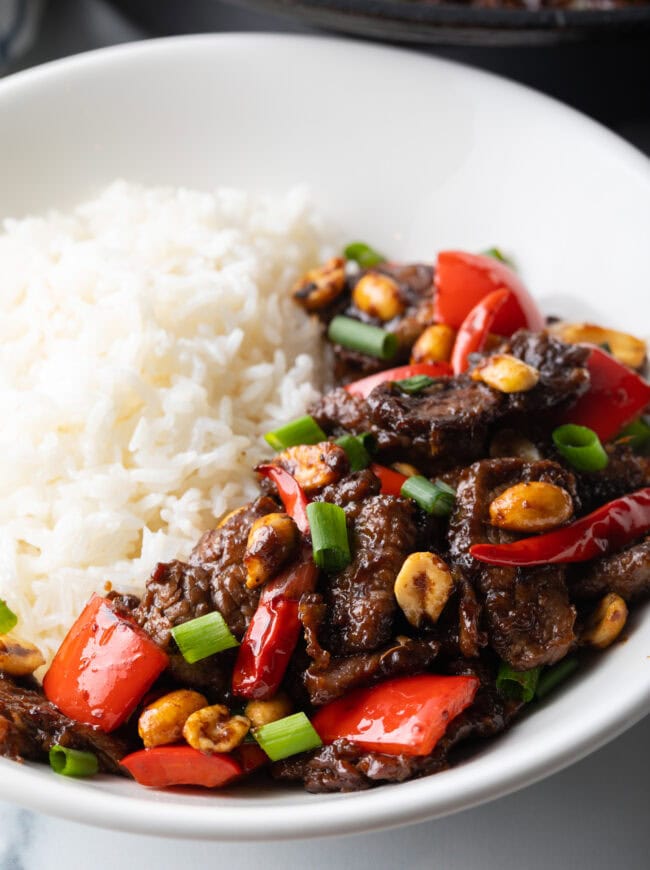

Sommer’s Recipe Notes
If you love Kung Pao Chicken you will go crazy over our savory robust Kung Pao Beef Stir Fry Recipe! This recipe has the tantalizing flavor of most savory beef dishes yet with the spicy POW associated with Kung Pao Chicken from the Sichuan province of China.
The spicy heat comes from a combination of Szechuan peppercorns and Chinese red peppers. You can reduce, or omit, one or the other to control the heat. Note, Kung Pao chilies are meant to be served on the plate for visual effect, but not necessarily meant to be eaten. They are HOT!
Why You’ll Love This Kung Pao Beef
- Better than takeout – This stir fry dish is loaded with fresh and nutritious ingredients that makes it so much better for you than classic takout!
- Meal-prep hero – Make big batches of this Kung Pao Beef and enjoy leftovers throughout the week.
- Bold flavors – Made with tender beef, crunchy peanuts and vibrant vegetables, this dish screams bold flavors.
One of the many great things about this recipe is that it is super easy to tweak to your tastes! Unlike restaurant Chinese takeout versions, homemade stir-fried beef allows you to decrease or omit the spiciness.
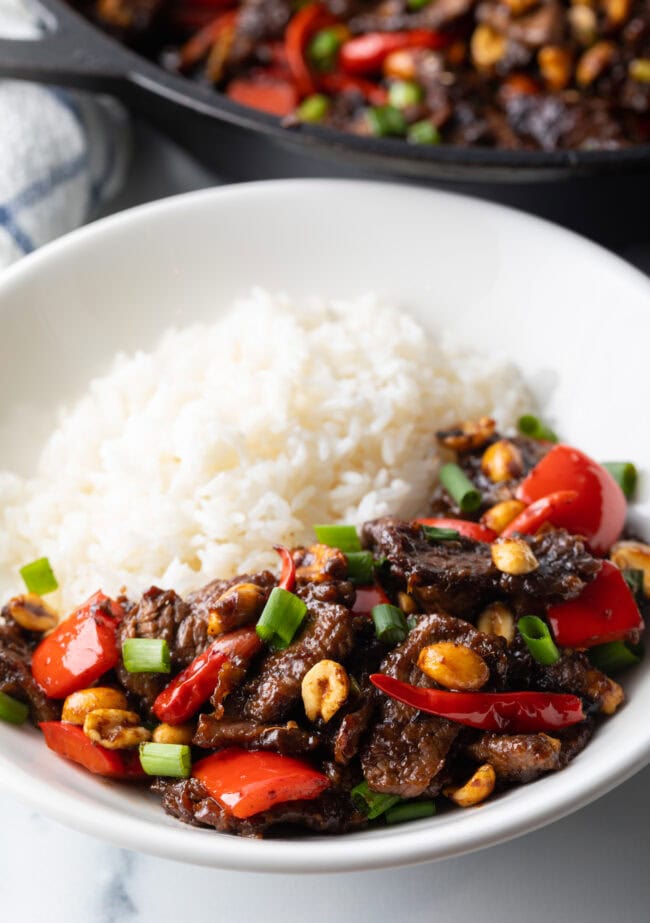
Ingredients
- Flank steak – This is the perfect thin, lean, and budget-friendly cut of meat for stir-frying.
- Cornstarch – You’ll need cornstarch to create a thick sauce without flour.
- Veggies – Use chopped scallions, seeded and chopped red bell peppers, grated ginger, minced garlic, and Chinese Tien Tsin chilies.
- Cooking sherry – To get that delicious depth of flavor use cooking sherry or rice wine.
- Soy sauce – I definitely suggest low sodium soy sauce.
- Szechuan peppercorns – To get that spicy finish don’t forget the Szechuan peppercorns.
- Roasted peanuts – Use salted or unsalted peanuts as a garnish.
Recipe Variations and Dietary Swaps
- Mild – For a mild Kung Pao beef you can reduce or leave out the spicy chile peppers and peppercorns.
- Bell peppers – Traditionally red bell peppers are included in the dish. But you can use different bell peppers of any color.
- Hoisin or oyster sauce – In a pinch, you can substitute black bean garlic sauce with hoisin or oyster sauce.
- Vinegar – White rice vinegar or a bit of balsamic vinegar can replace the Chinese black vinegar if not available.
- Alcohol-free – Leave out the cooking sherry for a stir-fry recipe without alcohol. Substitute with chicken broth or water, if you like.
- Peanut-free – If you have a peanut allergy or just don’t like them, feel free to leave out the peanuts or serve on the side to let others add.
- Veggies – For more color and variety, toss in other veggies like zucchini, carrots, green beans or snap peas.
- Protein – This recipe is versatile, so feel free to swap the beef with other proteins like chicken, pork, shrimp or even tofu for a vegetarian/vegan option.
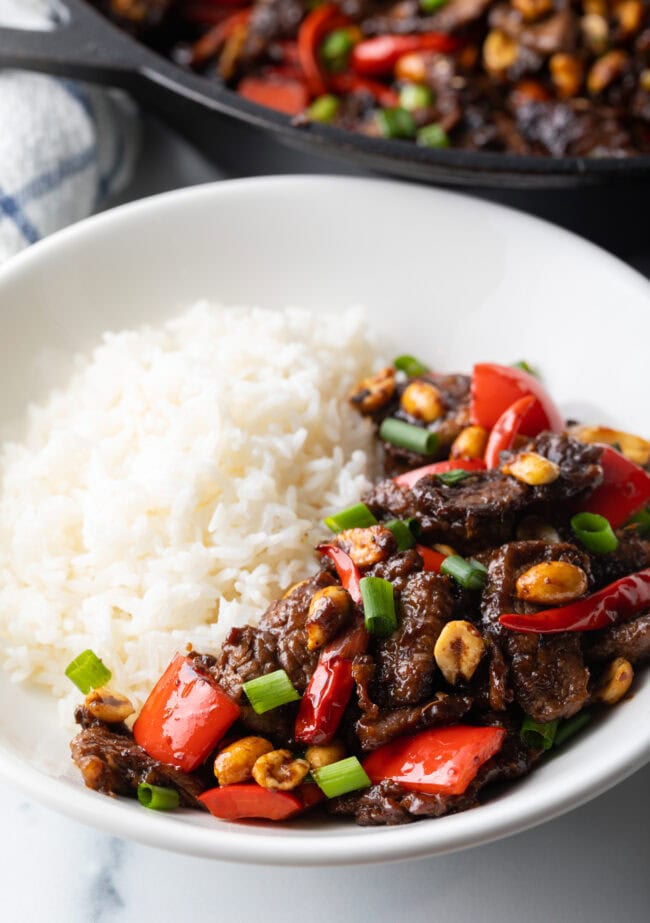
How To Make Kung Pao Beef
Heat up your skillet or wok and get ready to fry up that tender beef and chopped fresh veggies. This delicious and sizzling Kung Pao Beef will be ready in no time!
Find the full Kung Pao Beef recipe with detailed instructions and storage tips in the printable form at the bottom of the post!
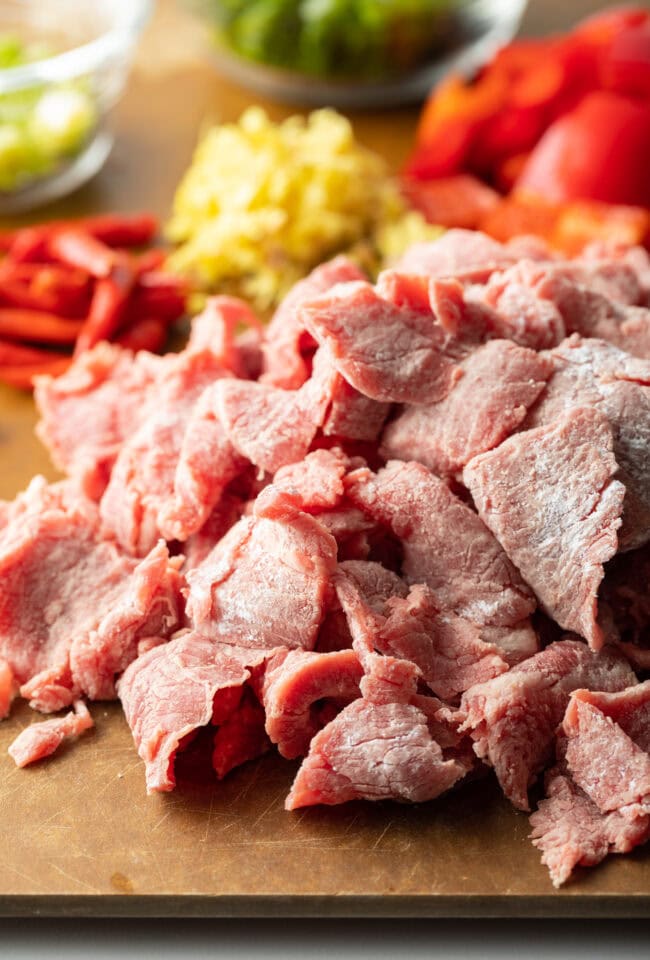
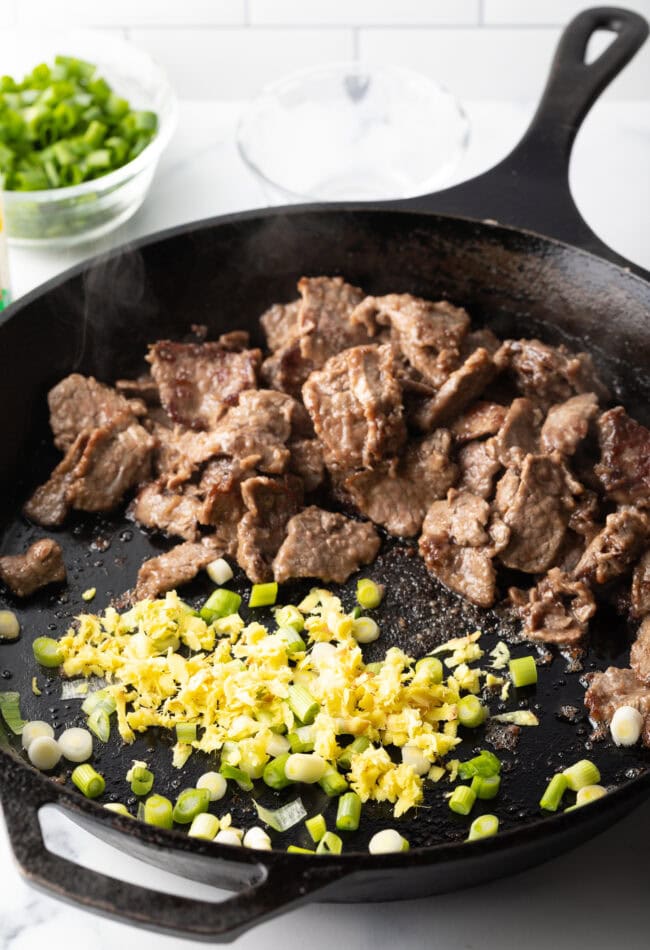
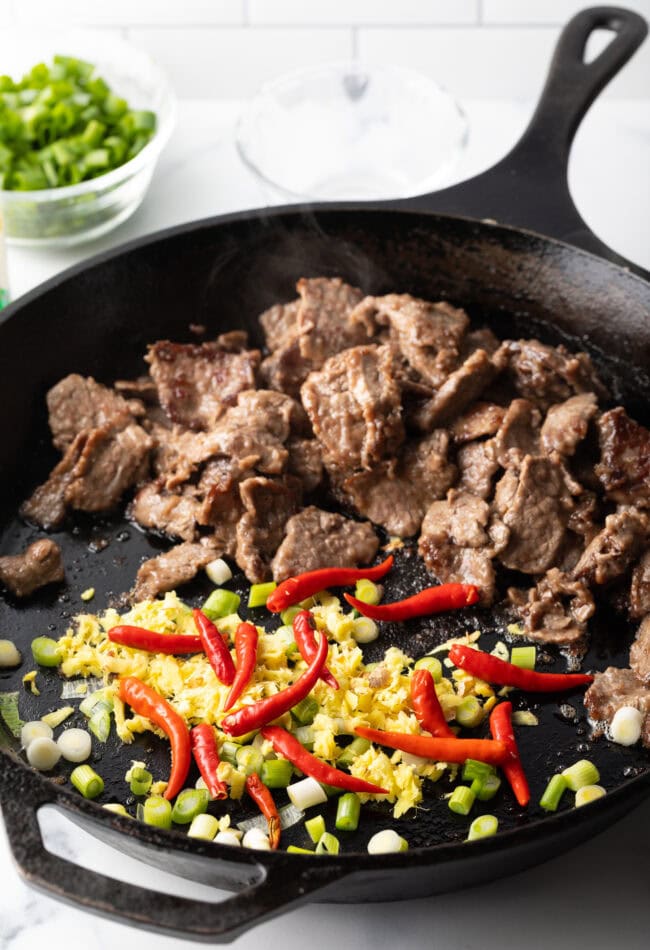
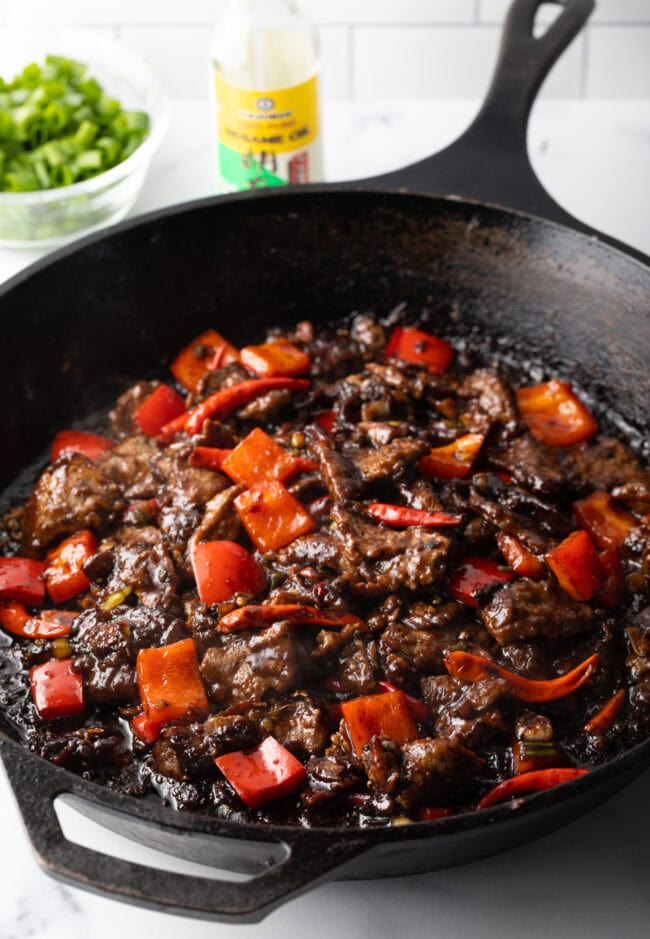
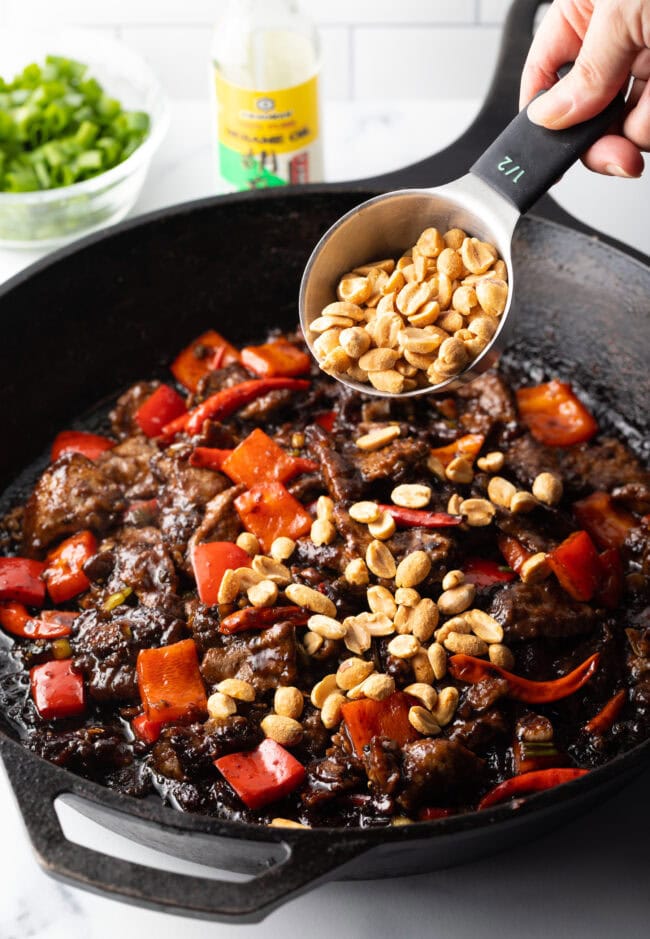
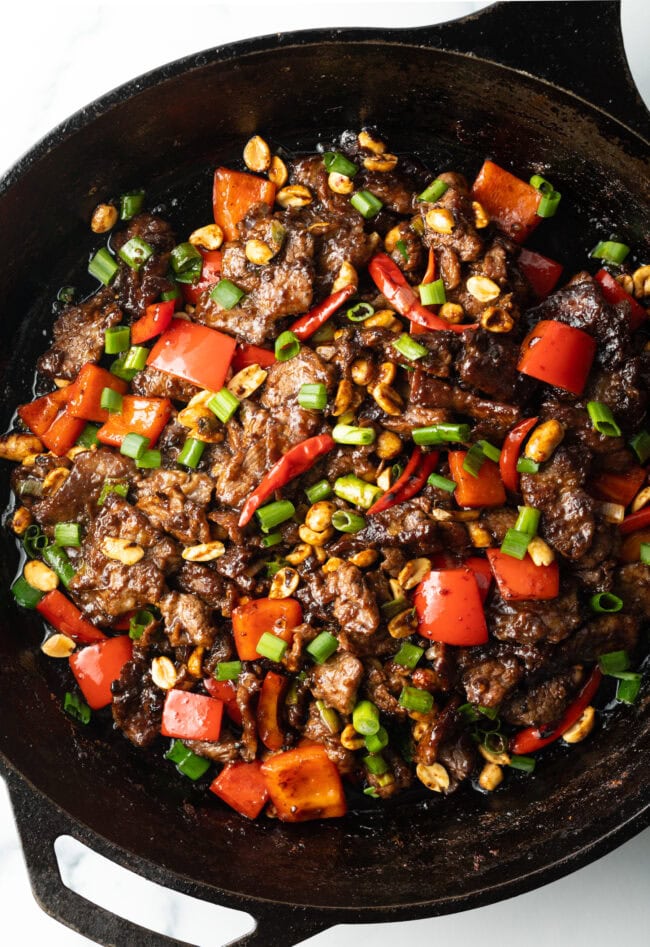
Tips For Success
- The black bean garlic sauce, Chinese black vinegar and soy sauce are very salty, so we suggest using low-sodium soy sauce, and do not add additional salt.
- Tossing the steak in the freezer for 30 minutes before slicing will make it easier to get thin, even slices.
- Always cut the steak against the grain to break down the muscle fibers, ensuring tender meat.
Storage Notes
- Storing Leftovers – Place leftovers in an airtight container and store in the refrigerator for 3-4 days.
- Reheating Leftovers – Reheat leftovers in a skillet over medium heat or in the microwave in short bursts.
Serving Suggestions
Serve tender, spicy, savory, and saucy beef stir fry with fluffy white rice or brown rice.
For a low-carb version of this Chinese dish, pair it with Roasted Cauliflower Rice or Broccoli Rice.
Make it a complete family-style meal and enjoy it with homemade Veggie Lo Mein, Chinese Dumplings (potstickers), Panda Express Super Greens, and Egg Drop Soup. Serve everything in individual dishes and let everyone dig in!

Kung Pao Beef Recipe
Video
Ingredients
- 4 tablespoons sesame oil divided
- 1 ½ pounds flank steak
- 2 tablespoons cornstarch
- 1 bunch scallions divided
- 1 large red bell pepper seeded and chopped into 1 inch pieces
- 10-15 Chinese Tien Tsin chilies or thai bird’s eye chiles
- 3 cloves garlic minced
- 2 tablespoons grated ginger
- ¼ cup cooking sherry
- 3 tablespoons low sodium soy sauce
- 2 tablespoons black bean garlic sauce
- 1 tablespoon Chinese black vinegar
- 1 tablespoon Szechuan peppercorns
- ½ cup roasted peanuts
Instructions
- Cut the flank steak in half, against the grain. Then cut each half into very thin slivers. *Flash freezing the steak, to make it firm, makes the slicing process easier. If you have time, throw the flank steak in the freezer for 30 minutes before slicing.
- Toss the flank steak strips with 2 tablespoons of cornstarch and set aside.
- Chop the scallions, and separate into whites and greens. Then chop the red bell pepper, mince the garlic, and grate the ginger.
- Set an extra-large skillet, or a wok, over high heat. Add 2 tablespoons of sesame oil to the skillet and swirl around to make sure it is completely coated in oil.
- Once the skillet is hot, stir fry the beef slices until seared brown on all sides.
- Move the beef slices to the side of the pan. Pour the remaining 2 tablespoons of sesame oil into the skillet, and add the scallion whites, red bell peppers, Chinese chilies, garlic, and ginger. Stir fry the vegetables for 3 to 4 minutes to soften.
- Now, pour the cooking sherry over the top of the vegetables, followed by the soy sauce, black bean garlic sauce, black vinegar, and Szechuan peppercorns. Mix the sauce and vegetables into the seared beef, making sure it is coated on all sides. If the sauce seizes up too much, add 2 to 4 tablespoons of water to the sauce to loosen.
- Once the sauce is to your desired consistency, stir in the peanuts, and scallion greens. Serve warm over steamed rice, or over cauliflower rice for a lower carb version.
Notes
Nutrition
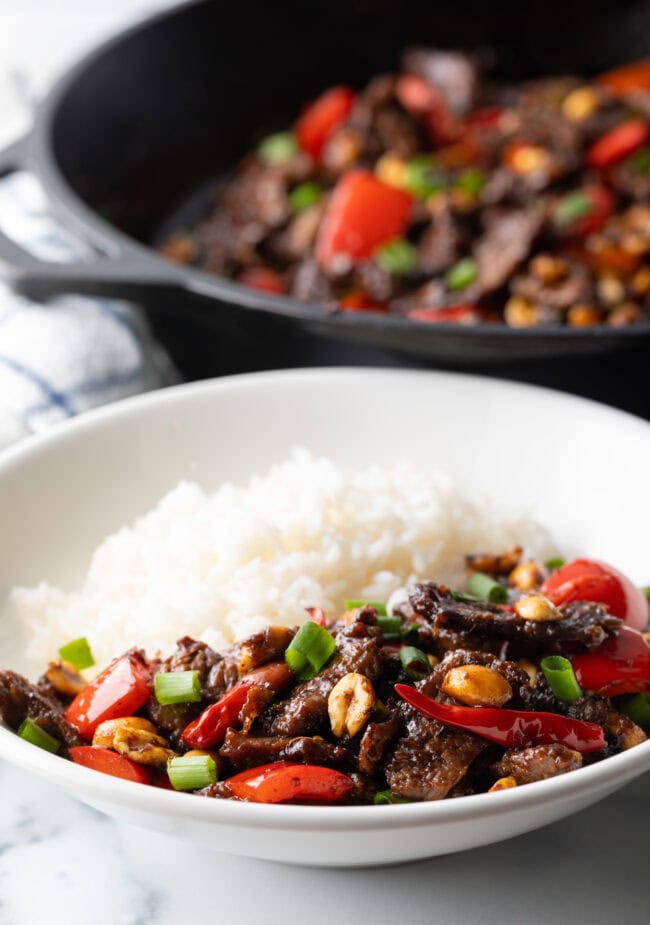
Frequently Asked Questions
Yes! This recipe has both spicy chiles and Szechuan peppercorns. You can omit these for a mild dish.
The stir-fried beef is tender with a bit of great chewiness. Each piece of meat and the sweet bell peppers is coated with a thick savory and spicy sauce. So the entire dish has a delicious punch of heat and a nice umami/sweet balance of flavors.
Mongolian Beef includes a sweeter sauce made with brown sugar, soy sauce, and ginger. It is not at all a spicy dish (unless you add crushed red pepper), so is a better option for folks that don’t appreciate the heat of Kung Pao.
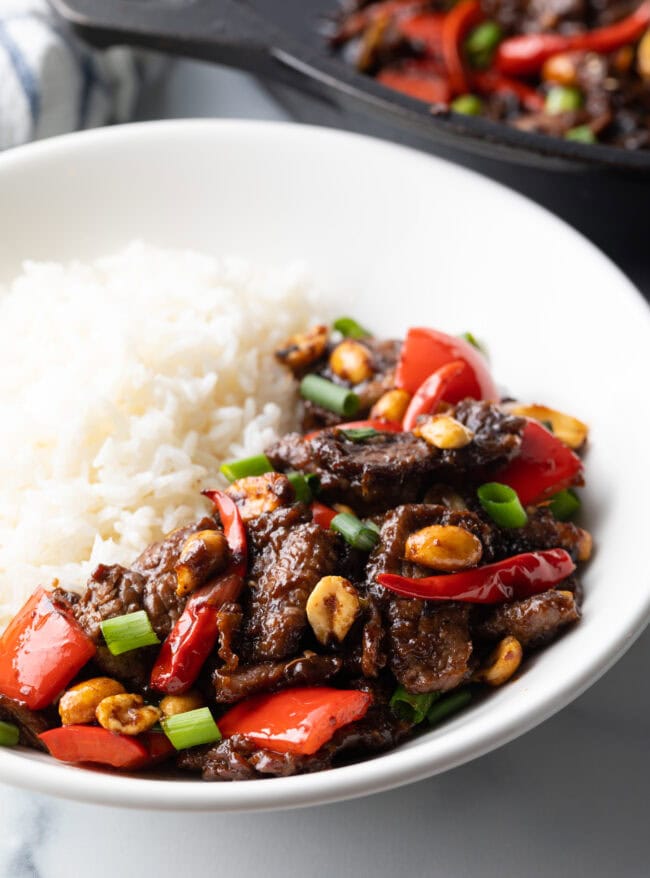

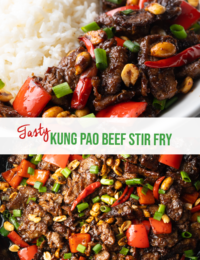
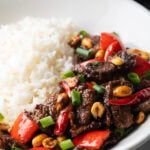



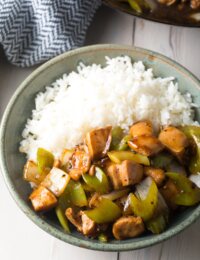


Holy cow, this Kung Pao Beef was AMAZING! It was so much better than take-out and surprisingly easy to make. My family has already asked when I can make it again! And I had no problem finding the more unusual ingredients at my local Asian market. :)
This recipe is a keeper! My family absolutely loved it! I did skip out on the peanuts, because they were going to pick them out anyways. This dinner was a hit! Thanks for posting!